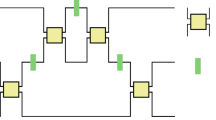Abstract
Optical Poincare sphere rotations \(e^{-i\theta\sigma_{x}/2}\), \(e^{-i\theta\sigma_{y}/2}\) and \(e^{-i\theta\sigma_{z}/2}\) can be realized by wave-plate combinations. Errors due to combinations with non-ideal wave plates are discussed for three specific combinations (θ=π) by trace distance. The result shows that different settings of combinations affect trace distance: (i) trace distance for \(e^{-i\pi\sigma_{x}/2}\) equals that for \(e^{-i\pi\sigma_{z}/2}\), but both of them are smaller than that for \(e^{-i\pi\sigma_{y}/2}\), when optics-axis random errors are considered; (ii) trace distance for \(e^{-i\pi\sigma_{x}/2}\) also equals that for \(e^{-i\pi\sigma_{z}/2}\), but both of them are larger than that for \(e^{-i\pi\sigma_{y}/2}\), when phase-shift random errors are considered. The method outlined in this paper is general and is useful to analyze other combinations.

Similar content being viewed by others
References
Wang, J., Fang, Q., Wang, Y.: Two novel polarization transformers using rotatable waveplates. Optik—Int. J. Light Electron Opt. 116(2), 93–98 (2005)
Langford, N.K.: Encoding, manipulating and measuring quantum information in optics. Ph.D. Thesis, University of Queensland (2007)
Wang, J., Li, J.: Error analysis on two-waveplate polarization state transformers by geometry method. Optik—Int. J. Light Electron Optics 121(8), 711–714 (2010)
Viola, L., Lloyd, S.: Dynamical suppression of decoherence in two-state quantum systems. Phys. Rev. A 58, 2733–2744 (1998)
Viola, L., Knill, E., Lloyd, S.: Dynamical decoupling of open quantum systems. Phys. Rev. Lett. 82, 2417–2421 (1999)
Cywiński, Ł., Lutchyn, R.M., Nave, C.P., Das Sarma, S.: How to enhance dephasing time in superconducting qubits. Phys. Rev. B 77, 174509 (2008)
Biercuk, M.J., Doherty, A.C., Uys, H.: Dynamical decoupling sequence construction as a filter-design problem. J. Phys. B, At. Mol. Opt. Phys. 44(15), 154002 (2011)
Su, Z.-K., Jiang, S.-J.: Filter-design perspective applied to dynamical decoupling of a multi-qubit system. J. Phys. B, At. Mol. Opt. Phys. 45(2), 025502 (2012)
Bardhan, B.R., Anisimov, P.M., Gupta, M.K., Brown, K.L., Jones, N.C., Lee, H., Dowling, J.P.: Dynamical decoupling in optical fibers: preserving polarization qubits from birefringent dephasing. Phys. Rev. A 85, 022340 (2012)
Yan, B., Li, C.-F., Guo, G.-C.: Preserving entanglement of flying qubits in optical fibers by dynamical decoupling (2011). arXiv:1111.6670
Lucamarini, M., Di Giuseppe, G., Damodarakurup, S., Vitali, D., Tombesi, P.: Suppression of polarization decoherence for traveling light pulses via bang-bang dynamical decoupling. Phys. Rev. A 83, 032320 (2011)
Lucamarini, M., Di Giuseppe, G., Vitali, D., Tombesi, P.: Open-loop and closed-loop control of flying qubits. J. Phys. B, At. Mol. Opt. Phys. 44(15), 154005 (2011)
Berglund, A.J.: Quantum coherence and control in one-and two-photon optical systems (2000). arXiv:quant-ph/0010001
Nielsen, M.A., Chuang, I.L.: Quantum Computation and Quantum Information. Cambridge University Press, Cambridge (2000)
Acknowledgements
This work is supported by the Ph.D. Start-up Fund of Natural Science Foundation of Foshan University, the High-quality lesson Foundation of Foshan University (Photoelectric information and technology experiment) and the National Natural Science Foundation of China under grant no. 61307062, no. 61275059 and no. 61008063.
Author information
Authors and Affiliations
Corresponding author
Appendix: Derivation
Appendix: Derivation
This appendix describes the derivation of (27) and (28) in detail. First, we prove (27) from
Then it follows
So it yields
Therefore, we obtain
According to (23) and (24), we have (27).
Next, we prove (28) from
Then it follows
Therefore, we obtain
Rights and permissions
About this article
Cite this article
Su, ZK., Xie, JN., Li, N. et al. Error Analysis on Photonic Qubit Rotations Implemented by Wave Plates. Int J Theor Phys 53, 1056–1063 (2014). https://doi.org/10.1007/s10773-013-1899-2
Received:
Accepted:
Published:
Issue Date:
DOI: https://doi.org/10.1007/s10773-013-1899-2




